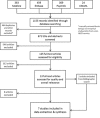A paucity of strategies for developing health literate organisations: A systematic review
- PMID: 29641544
- PMCID: PMC5895007
- DOI: 10.1371/journal.pone.0195018
A paucity of strategies for developing health literate organisations: A systematic review
Abstract
Introduction: People with low health literacy are more likely to delay seeking care and experience adverse outcomes. While health literacy is the product of individuals' capacities, it is also affected by the complexities of the health care system. System-level changes are needed to align health care demands better with the public's skills and abilities. We aimed to identify the evidence base for effective strategies for creating health literate organisations.
Methods: A systematic review and narrative synthesis of empirical studies was performed. Medline, Embase, PsychInfo and CINHAL databases were searched for empirical studies from OECD countries published from 2008 onwards, focusing on health literacy interventions at the organisational level. Analysis of the findings was informed by the National Academies' five-dimensional framework for the attributes of a health literate organisation, which include: organisational commitment, accessible education and technology infrastructure, augmented workforce, embedded policies and practices, and effective bidirectional communication.
Results: The title and abstract of 867 records were screened according to the selection criteria, leading to full text review of 125 articles. Seven studies were identified in the peer review literature. Adapting health literacy guidelines and tools was the most common approach to addressing organisational health literacy.
Conclusion: While the use of health literacy tools proved important for raising awareness of health literacy issues within organisations, these tools were insufficient for generating the organisational changes necessary to improve organisational health literacy.
Conflict of interest statement
Figures
References
-
- Australian Insitute of Health and Welfare. Australia's Health 2014. Canberra: AIHW, 2014. Contract No.: 14.
-
- Australian Commission on Safety and Quality in Health Care. Health Literacy: Taking Action to Improve Safety and Quality. Sydney, Australia: ACSQHC; 2014.
-
- Koh H, Baur C, Brach C, Harris LM, Rowden JN. Toward a Systems Approach to Health Literacy Research. J Health Commun. 2013;18(1):1–5. doi: 10.1080/10810730.2013.759029 - DOI - PMC - PubMed
-
- Brega AG, Barnard J, Mabachi NM, Weiss BD, DeWalt DA, Brach C, et al. AHRQ Health Literacy Universal Precautions Toolkit: Second Edition In: Services USDoHaH, editor. Rockville, MD: Agency for Healthcare Research and Quality; 2015.
-
- Rudd R, Comings JP, Hyde JN. Leave no one behind: improving health and risk communication through attention to literacy. J Health Commun. 2003;8(S1):S104–S15. - PubMed
Publication types
MeSH terms
LinkOut - more resources
Full Text Sources
Other Literature Sources
Medical



